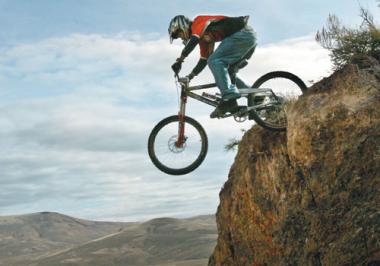Using a bike for everyday commuting makes more sense every day that the price of gas hits a new record. Saddling the family up for an afternoon bike ride is taking the place of the Sunday drive of long ago.
If you haven't shopped for a bike in quite a while, the number of products available these days can be a little daunting. TrekBikes, for example, has three separate catalogs, one for road bikes, one for mountain bikes and one for what they call lifestyle. The road bike catalog alone contains 37 different models and the lifestyle catalog has a whopping 55 choices.
Before you pick a bike, you need to decide what you like to do— and what you may want to do in the future. You may ride easy roads around a reservoir at first, but then eventually you might want to take a right turn and head off into the woods.
Crosstrail and cyclocross bikes go on road or dirt. But no bike can do everything. They are perfect for mixing some off-road and some street riding. (That may be your commute.) You just can't expect them to take big hits on single track.
It's similar for road bikes. Do you want to take a leisurely short ride once in a while, or will you get involved in group rides, or maybe longer fundraiser rides? A better bike can do both.
There are road bikes that are faster from point to point. These would be for racing or riding with faster groups. If the ride itself is more important than getting to the finish line, there are more comfortable road bikes that can go the distance. They have a longer wheel base and the handlebars are a little higher.
Commuter bikes can fight high gas prices and obesity all at once. Urban and fitness bikes have straight handlebars like mountain bikes instead of dropped handlebars like road bikes. This gives you more control and maneuverability and makes you more visible in city riding. But they are less efficient for really long rides.
Hybrid bikes have suspension forks and seatposts and can go lots of places. They are generally for shorter rides and are geared for comfort. Handlebars are even higher, seats are bigger and tires thicker. These are perfect for the rail trail or riding around with the kids.
In this category there are two different styles. There is an easier-rolling bigger wheel that's the size of a road bike. This will ride more smoothly for somewhat longer trips. You can also get a bike with smaller wheels and thicker tires, like a mountain bike.
The latter is good for someone who hasn't been on a bike for a while and wants more stability. It gives you a lower center of gravity and a plush ride for leisure travel on shorter distances. It's also great for pulling a child in a trailer or on a tagalong bike.
Most bike models are also available in designs adapted specifically for women. These are not just the dropped-top tube style. There are high-performance road and mountain bikes just for women. They are lighter in weight and have wider gear ranges, narrower handlebars and seats designed for women.
When you consider what kind of riding you will be doing, a good number of bikes can be scratched off the list. Then it's easier to pick from the few that are left. With so many choices, there's bound to be a bike that suits your needs. Try some out and get a good fit. With a little forethought and research, you'll find a bike that is perfect for you."
Bob Weiss works at Competitive Edge Ski & Bike.



